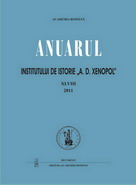Mănăstirea Golia: reper al organizării spaţiului urban
THE GOLIA MONASTERY: LANDMARK OF URBAN SPACE ORGANIZATION
Author(s): Marius Chelcu, Cătălina ChelcuSubject(s): History
Published by: Editura Academiei Române
Keywords: urban economy; town-planning; metochions; Balkan influences; Mount Athos
Summary/Abstract: The authors, trying to discover some fixed elements in the urban development of the cities of Moldavia, focused their attention on a church located in the historical area of the city of Iaşi. At the end of the 16th century, after the Saint Sava Monastery was established by monks coming from Jerusalem, with the support of Moldavia’s Prince, a series of monasteries will appear in the city. One of these is the Golia church, which, at the beginning of the 17th century, was transformed, at the founders’ desire, from a parish church to a monastery church as a metochion of Mount Athos. This status and the position that churches like Golia occupy on the city map impose a given type of organization of the surrounding area. The neighbouring space gets an obvious economic nature, as along an intensely circulated thoroughfare there are plenty of shops and workshops, most of them on the church’s land. In the same areas inns are built, whose incomes are intended to the monasteries as well, and in order to facilitate the circulation, the Court starts in these places pavement works too. All these elements can be identified in the area in front of the Golia Tower. The resemblances observed led to the conclusion that this type of organization of the urban area was not the result of fate, but it pertained to a well-outlined town-planning system. Looking for possible influences for the apparition of this model of urban organization, the authors realized that in the same period, in the Balkan cities, the commercial areas included workshops and shops along a covered or uncovered thoroughfare, where the traffic was improved by paving. In the same complex, there were the caravanserai and the stables. All these arrangements were exclusively the job of the central authorities and not of the citizens.
Journal: Anuarul Institutului de Istorie »A.D. Xenopol« - Iaşi
- Issue Year: XLVIII/2011
- Issue No: 48
- Page Range: 223-239
- Page Count: 24
- Language: Romanian

